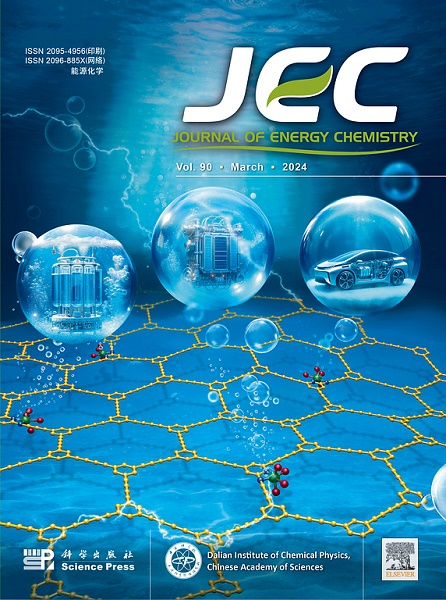Co-electrolysis of carbon dioxide and ferrous oxide in Ca-based molten salt to iron-encapsulated carbon nanotubes with enhanced microwave absorption
IF 13.1
1区 化学
Q1 Energy
引用次数: 0
Abstract
Direct utilization of co-existed ferrous oxide (FeO) dust in CO2 flue gas from the steel industry to product value-added materials is yet to be established. Inspired by the form of CaO-CaCO3 as natural carbon cycle and the high oxide dissolution capacity of molten salts, CaO is herein introduced into the affordable molten NaCl-CaCl2-FeO salt to generate CO32− through an efficient capture of CO2. The subsequent co-electrolysis of FeO and CO32− successfully produces cathodic Fe-encapsulated carbon nanotubes (Fe@CNT) with enhanced energy efficiency (current efficiency of 83.1% for CO2 reduction and energy consumption of 22.49 kWh kg−1 for Fe@CNT generation). The in-situ capture of CO2 by O2− generated from the electro-deoxidation of FeO bridges the electrolysis of CO2 and FeO, rendering the enhanced current efficiency of the co-electrolysis and template-free generation of Fe@CNT. When evaluated as functional materials for electromagnetic wave absorption, the Fe@CNT integrates dielectric loss of CNT and electromagnetic loss from Fe. The Fe well-defined in CNT induces the synergistic loss and further improves the impedance matching, resulting in excellent electromagnetic wave absorption performance. The co-electrolysis establishes a promising strategy for converting CO2 into highly functional materials directly from CO2-containing flue gas from steel industrial without dust removal.

求助全文
约1分钟内获得全文
求助全文
来源期刊

Journal of Energy Chemistry
CHEMISTRY, APPLIED-CHEMISTRY, PHYSICAL
CiteScore
19.10
自引率
8.40%
发文量
3631
审稿时长
15 days
期刊介绍:
The Journal of Energy Chemistry, the official publication of Science Press and the Dalian Institute of Chemical Physics, Chinese Academy of Sciences, serves as a platform for reporting creative research and innovative applications in energy chemistry. It mainly reports on creative researches and innovative applications of chemical conversions of fossil energy, carbon dioxide, electrochemical energy and hydrogen energy, as well as the conversions of biomass and solar energy related with chemical issues to promote academic exchanges in the field of energy chemistry and to accelerate the exploration, research and development of energy science and technologies.
This journal focuses on original research papers covering various topics within energy chemistry worldwide, including:
Optimized utilization of fossil energy
Hydrogen energy
Conversion and storage of electrochemical energy
Capture, storage, and chemical conversion of carbon dioxide
Materials and nanotechnologies for energy conversion and storage
Chemistry in biomass conversion
Chemistry in the utilization of solar energy
 求助内容:
求助内容: 应助结果提醒方式:
应助结果提醒方式:


